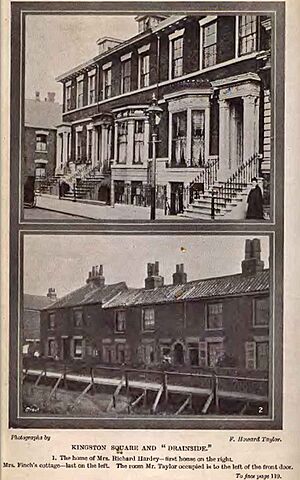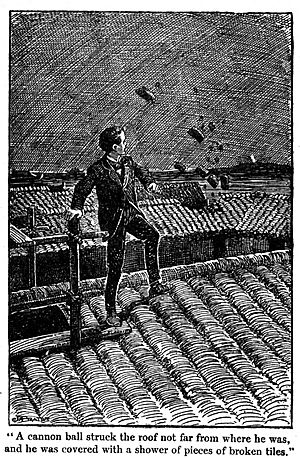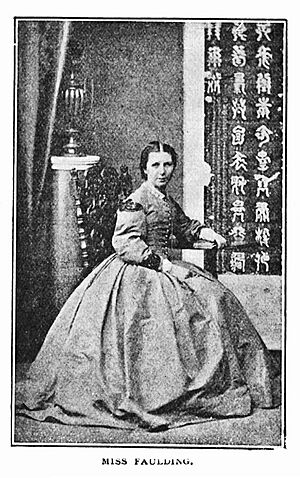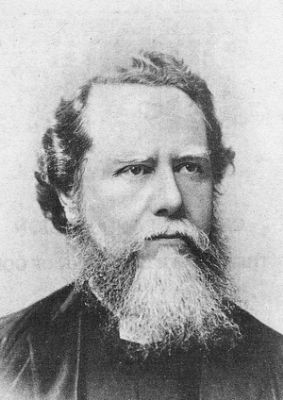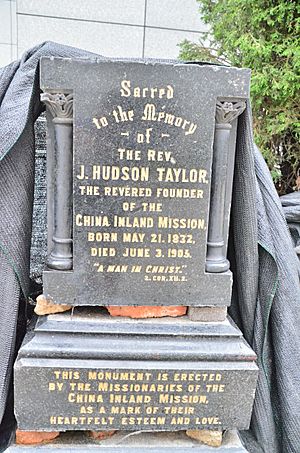Hudson Taylor facts for kids
Quick facts for kids James Hudson Taylor |
|
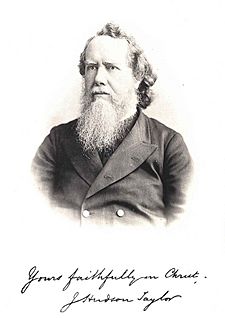 Taylor in 1893 with handwritten note and signature |
|
| Born | 21 May 1832 in Barnsley, Yorkshire, United Kingdom |
|---|---|
| Died | 3 June 1905 (aged 73) in Changsha, Hunan, China |
| Church | Baptist |
| Education | Royal College of Surgeons |
| Title | MRCS FRGS |
| Spouse | Maria Jane Taylor (née Dyer); Jennie Taylor (née Faulding) |
| Parents | James Taylor Amelia Hudson |
James Hudson Taylor (Chinese: 戴德生; born May 21, 1832 – died June 3, 1905) was a British Christian missionary. He founded the China Inland Mission (CIM). Taylor lived and worked in China for 54 years. His mission brought over 800 missionaries to China. They started 125 schools and helped 20,000 Chinese people become Christians. They also set up over 300 work centers across China.
Taylor was known for respecting Chinese culture. He was also very eager to share his Christian faith. He chose to wear traditional Chinese clothes. This was unusual for missionaries at that time. Under his leadership, the CIM welcomed members from all Protestant Christian groups. This included working-class people and single women. People from many different countries joined. Taylor is seen as one of the most important Europeans to visit China in the 1800s.
Taylor could preach in several Chinese languages. These included Mandarin, Chaozhou, and the Wu dialects of Shanghai and Ningbo. He knew the Ningbo dialect well enough to help create a New Testament in that language.
Contents
Early Life and Training
James Hudson Taylor was born on May 21, 1832. His hometown was Barnsley, Yorkshire, England. His father was a chemist and a Methodist preacher. As a young man, James moved away from his parents' Christian beliefs.
At age 16, he read a Christian pamphlet. After reading it, he decided to follow Christ. In December 1849, he felt called to go to China as a missionary. Around this time, he met Edward Cronin. Edward was one of the first missionaries to Baghdad. Taylor learned about "faith missions" from him. This meant trusting God to provide for all needs.
Taylor borrowed a book called China: Its State and Prospects. He read it quickly. He also began studying several languages. These included Mandarin Chinese, Greek, Hebrew, and Latin. In 1851, he moved to a poor area in Kingston upon Hull. He worked as a medical assistant. He prepared for a life of service. He gave out Christian pamphlets and preached outdoors. He was baptized in 1852.
In 1852, he started studying medicine. He went to the Royal London Hospital in London. This was to prepare him for working in China. At this time, many people in England were interested in China. This was because of a civil war there called the Taiping Rebellion. This led to the creation of the Chinese Evangelisation Society. Hudson Taylor offered to be their first missionary.
First Journey to China
Taylor left England on September 19, 1853. He did not finish his medical studies. He sailed from Liverpool and arrived in Shanghai, China, on March 1, 1854. The journey was long and difficult, lasting about five months. In China, he immediately faced a civil war. This made his first year very challenging.
Starting in 1855, Taylor made 18 preaching trips. He traveled around Shanghai. People often did not welcome him. He brought medical supplies and skills, but it was still hard. He decided to wear Chinese clothes and a pigtail (queue). This was so he could meet people without causing trouble. Before this, people called him a "black devil" because of his foreign coat. He gave out thousands of Christian pamphlets and Bible parts. While in Shanghai, he also adopted a Chinese boy named Hanban.
A Scottish evangelist, William Chalmers Burns, worked in Shantou. Taylor joined him there for a while. Later, Taylor found that all his medical supplies in Shanghai were destroyed by fire. In October 1856, he was robbed while traveling. He lost almost everything he owned.
By 1857, Taylor was in Ningbo. He received a letter from a supporter, George Müller. This led Taylor and his co-worker, John Jones, to leave their mission board. They decided to work on their own. This became known as the "Ningbo Mission." Four Chinese men joined their work.
In 1858, Taylor married Maria Jane Dyer. She was the daughter of a missionary. Hudson met Maria in Ningbo. She worked at a girls' school there. They were married at the British Consulate. The Taylors adopted a boy named Tianxi. They had their own baby who died in 1858. Their first child to survive, Grace, was born in 1859. Soon after, the Taylors took over a hospital in Ningbo.
Because of health problems, Taylor decided to return to England in 1860. He went for a break with his family. The Taylors sailed back to England with Grace and a young Chinese man named Wang Laijun. Wang helped with Bible translation work in England.
Starting the China Inland Mission
In England, Taylor continued his work. He helped translate the New Testament into the Ningbo dialect. He also finished his medical studies in 1862. With Maria's help, he wrote a book called China's Spiritual Need and Claims in 1865. This book helped people care about China. It also encouraged volunteers to become missionaries.
Taylor traveled a lot in Britain. He spoke in churches about China's needs. He also helped people in Newgate Prison in London. During this time, he became friends with Charles Spurgeon. Spurgeon was a famous preacher who supported Taylor for many years.
More children were born to the Taylors in London. These included Herbert (1861), Frederick (1862), Samuel (1864), and Jane (1865), who died at birth.
On June 25, 1865, Taylor felt strongly called by God. He decided to start a new group to share the Christian message in China's inland areas. He founded the China Inland Mission (CIM) with William Thomas Berger. In less than a year, they had 21 missionaries. They also raised over £2,000. In early 1866, Taylor published the first CIM newsletter. It was later called China's Millions.
In 1866, Taylor and his team sailed to China. They left on May 26, 1866. This group was called "the Lammermuir Party." They sailed on a ship called the Lammermuir. The journey took four months, which was fast then. The ship faced two strong storms but arrived safely in Shanghai on September 30, 1866.
Returning to China
The arrival of so many missionaries caused a stir in Shanghai. People talked about the China Inland Mission. Some criticized them for wearing Chinese clothes. But Taylor believed that the Christian message would only be accepted if missionaries respected Chinese culture. He felt missionaries should become like the Chinese in everything "not sinful."
They traveled along the Grand Canal of China. They set up their first mission in Hangzhou. This city had been affected by war. Another daughter, Maria Hudson Taylor, was born there. Taylor worked very hard. He did medical work and preached every day. Hundreds of people came to hear him and get treatment.
There were some disagreements within the Lammermuir team. But when Taylor's daughter Grace died in 1867, they came together. They saw how Taylor cared more about his fellow missionaries than his own sick daughter. Many of the Lammermuir crew became Christians.
Yangzhou Incident
In 1868, the Taylors took a group of missionaries to Yangzhou. They wanted to start new work there. But in 1868, their mission building was attacked. It was looted and burned during the Yangzhou riot. No one was killed, but people were hurt.
This attack on British citizens caused international anger. The British Navy arrived. The China Inland Mission and Taylor were criticized in the British newspapers. Some even said they almost started a war. Taylor never asked for military help. Some in the British Parliament wanted all missionaries to leave China. However, the Taylors returned to Yangzhou later that year. They continued their work, and many Chinese people became Christians.
In 1869, Hudson was inspired by a book about personal holiness. He felt a new understanding of always staying close to Christ. He told a fellow missionary, "Oh, Mr. Judd, God has made me a new man!" This belief stayed with him for the rest of his life.
Loss and New Beginnings
In 1868, another child, Charles, was born. In 1870, Taylor and his wife made a difficult choice. They sent their three older surviving children back to England. Their son Samuel had died earlier that year. In July, their baby Noel was born, but he died two weeks later. Maria, Taylor's wife, died a few days later from cholera. Her death deeply affected Taylor. In 1871, his own health worsened. He returned to England to recover.
Back in England, Taylor married Jane Elizabeth Faulding. She had been a missionary with him since 1866. Hudson and "Jennie" returned to China in late 1872. They were in Nanjing when Jennie gave birth to stillborn twins in 1873. Two years later, the Taylors had to return to England again. This was because the mission secretary and their children's caretaker, Emily Blatchley, had died.
During the winter of 1874 and 1875, Taylor was almost paralyzed. He had fallen on a riverboat in China. Even with this physical challenge, Taylor confidently asked for 18 new workers to join the mission. When he recovered, Jennie stayed with the children in England. Hudson Taylor returned to China in 1876 with the 18 new missionaries. Meanwhile, Hudson's brother-in-law, Benjamin Broomhall, managed the China Inland Mission in England.
At this time, Taylor's work in England inspired the famous cricketing Studd family. Three of the brothers became deeply religious. One of them, Charles Studd, became a missionary to China. He went with other converts from Cambridge University, known as the Cambridge Seven.
From 1876 to 1878, Taylor traveled across inland China. He opened many mission stations. This was possible because of the Chefoo Convention signed in 1876. This agreement made it legal for missionaries to work in inland China. In 1878, Jennie returned to China. She worked to encourage more women to become missionaries. By 1881, the CIM had 100 missionaries.
Taylor returned to England in 1883 to find more missionaries. He spoke about China's needs. He then returned to China, now working with 225 missionaries and 59 churches. In 1887, 102 more missionaries joined. In 1888, Taylor brought 14 missionaries from the United States. In the U.S., he spoke in many places. He became friends with Cyrus Scofield. He also spoke at Dwight Lyman Moody's church in Chicago. Moody and Scofield then actively supported the China Inland Mission in North America.
In 1897, Hudson and Maria's only surviving daughter, Maria, died in Wenzhou. She left behind four young children. She had helped many Chinese women become Christians during her short life.
Boxer Uprising
News of the Boxer Rebellion in 1900 worried Taylor. This event caused great trouble for missionary work. However, it also led to more interest in missions. The China Inland Mission suffered more than any other mission. Fifty-eight missionaries and 21 children were killed. But Taylor refused to accept money for lost property or lives. He wanted to show the "meekness and gentleness of Christ." Some people criticized him for this. But the British Foreign Office praised him. They even donated money to the CIM. The Chinese people were also touched by Taylor's actions.
Final Years and Legacy
Because of health problems, Taylor stayed in Switzerland. He was semi-retired with his wife. In 1900, Dixon Edward Hoste became the Acting General Director of the CIM. In 1902, Taylor officially stepped down. His wife, Jennie, died of cancer in 1904. In 1905, Taylor returned to China for the last time. He visited Yangzhou and Zhenjiang. He died suddenly while reading at home in Changsha. He was buried next to his first wife, Maria, in Zhenjiang.
The small cemetery was later covered by industrial buildings in the 1960s. The grave markers were destroyed. However, Hudson Taylor's marker was kept in a local museum. His great-grandson, James Hudson Taylor III, found the marker. He helped a local Chinese church put it back in their building in 1999.
In 2013, the cemetery land was redeveloped. The old industrial buildings were torn down. This showed that the Taylors' tombs were still there. On August 28, the graves were dug up. They were moved to a local church. They were to be reburied in a memorial garden.
Lasting Impact
Taylor's idea of "faith missions" has had a big impact. This means sending missionaries who rely on prayer for their needs. After his death, the China Inland Mission became the largest Protestant mission group in the world. Hudson Taylor's life story inspired many Christians. They followed his example of service and sacrifice. Famous examples include Amy Carmichael, Eric Liddell, Jim Elliot, and Billy Graham.
James Hudson Taylor's family has continued his ministry. His great-grandson, James Hudson Taylor III (1929–2009), worked in Hong Kong. His son, James Hudson Taylor IV, is involved in ministry in Taiwan.
Chinese tourists now visit Taylor's hometown of Barnsley. They want to see where their hero grew up. The town is planning a special trail for visitors.
Beliefs
Taylor grew up in the Methodist tradition. Later, he was a member of the Baptist Westbourne Grove Church. He also had strong ties to other Christian groups.
Timeline of Key Events
- 1832: Born on May 21 in Barnsley, England.
- 1849: Decided to follow Christ and felt called to China.
- 1852: Began studying medicine in London.
- 1854: Arrived in Shanghai, China, for the first time.
- 1858: Married Maria Jane Dyer in Ningbo, China.
- 1860: Returned to England due to health issues.
- 1865: Founded the China Inland Mission (CIM).
- 1866: Sailed back to China with the "Lammermuir Party."
- 1867: His daughter Grace died in China.
- 1868: Survived a riot in Yangzhou, China.
- 1870: His wife Maria died in China.
- 1871: Married Jane Elizabeth Faulding.
- 1876: Returned to China after recovering from an injury.
- 1888: Brought missionaries from the United States to China.
- 1900: Retired due to health issues.
- 1904: His second wife Jennie died.
- 1905: Returned to China for the last time and died on June 3 in Changsha.
Works by Hudson Taylor
- China's Spiritual Need and Claims (1865)
- A Retrospect (1894)
- Separation and Service (1898)
Images for kids
See also
 In Spanish: Hudson Taylor (misionero) para niños
In Spanish: Hudson Taylor (misionero) para niños



